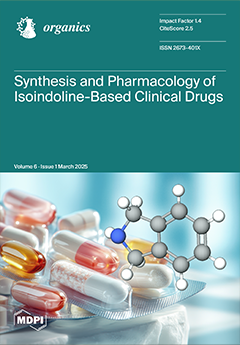Six secondary amine derivatives derived from salicylaldehyde (SA) were successfully synthesized in good to excellent yields and evaluated for their biological activities. The synthesized compounds exhibited remarkable antioxidant properties, as determined by ABTS and phenanthroline assays. Notably, compound
2 demonstrated an IC
50
[...] Read more.
Six secondary amine derivatives derived from salicylaldehyde (SA) were successfully synthesized in good to excellent yields and evaluated for their biological activities. The synthesized compounds exhibited remarkable antioxidant properties, as determined by ABTS and phenanthroline assays. Notably, compound
2 demonstrated an IC
50 value of 5.14 ± 0.11 µM in the ABTS assay, approximately six to nine times lower than the standards BHT and BHA. In the phenanthroline assay, all compounds showed inhibition capacities five to ten times greater than BHT and comparable to BHA, with A
0.5 values ranging from 9.42 to 31.73 µM. Among these, compound
5 displayed the lowest A
0.5 value of 9.42 ± 1.02 µM. The anti-inflammatory activity, assessed through BSA denaturation, revealed that compounds
2 and
5 were the most promising, although their activity was moderate compared to the standard diclofenac. The insecticidal potential of the compounds was evaluated against the storage insect pest
Tribolium castaneum. Among the tested derivatives, compounds
1 and
6 exhibited the highest efficacy, achieving maximum mortality rates of 73.31% and 76.67%, respectively, over a seven-day treatment period. Furthermore, the molecular geometry, electronic properties, and intramolecular interactions of all compounds were investigated using DFT calculations. Thermodynamic analyses of the antioxidant mechanisms suggested that the NH bond is the most likely site for free radical attacks. These findings underscore the significant biological potential of the synthesized salicylaldehyde-derived secondary amines.
Full article





